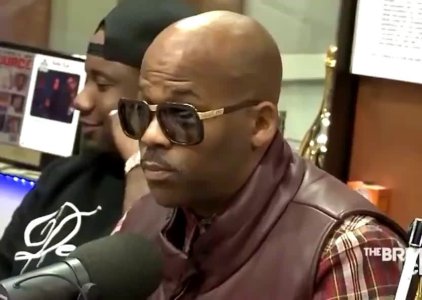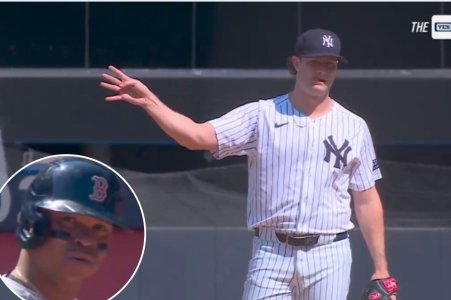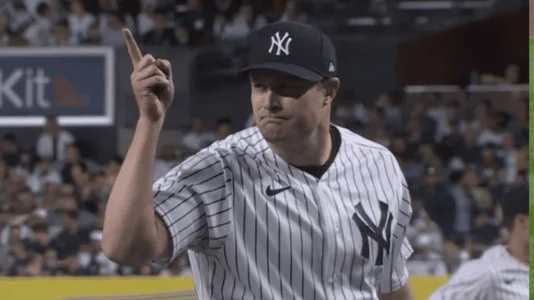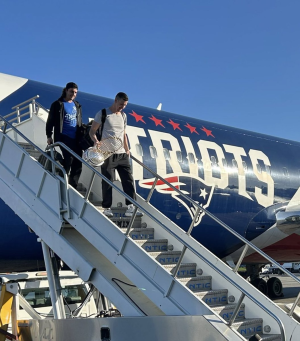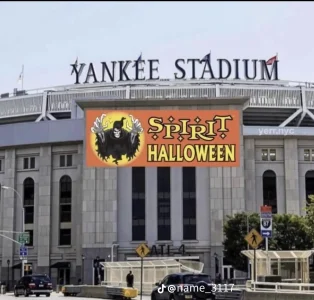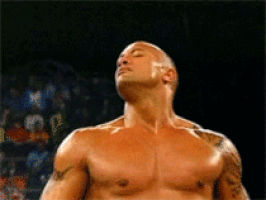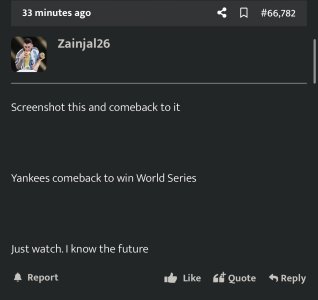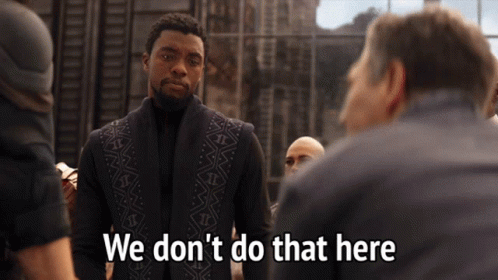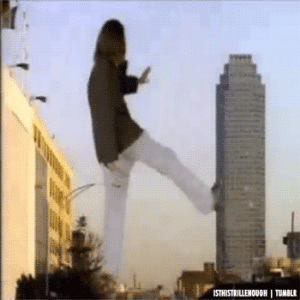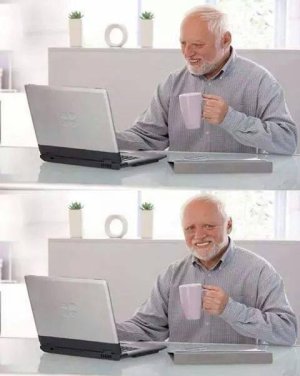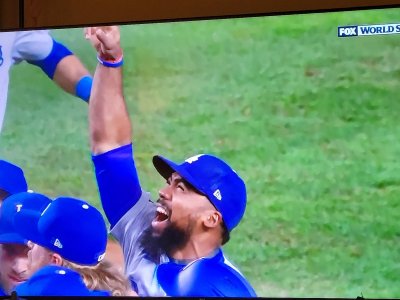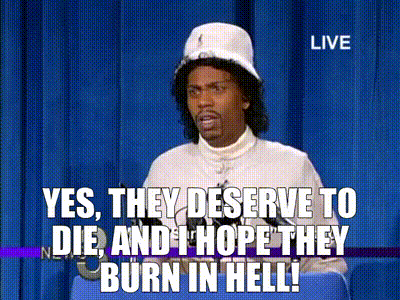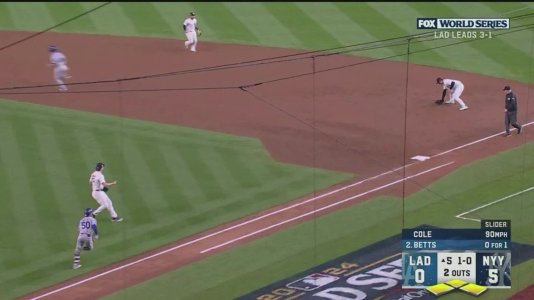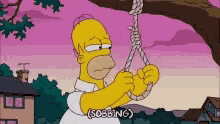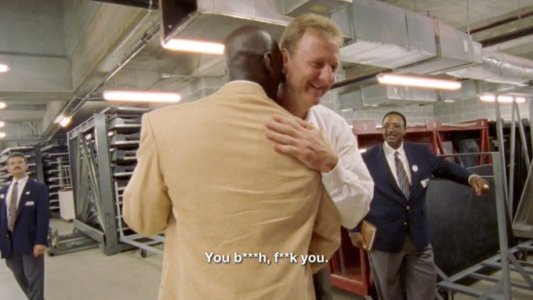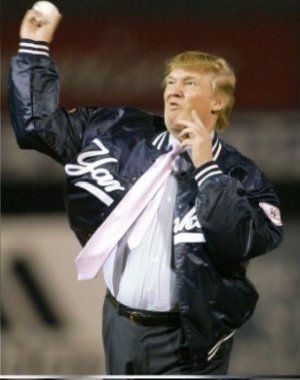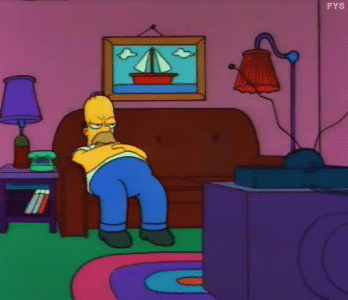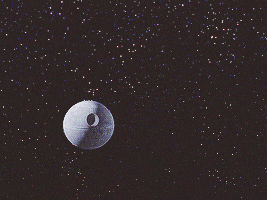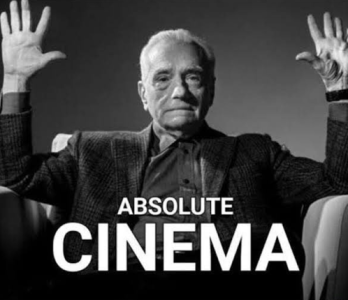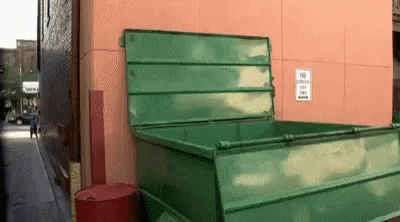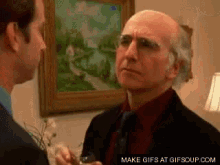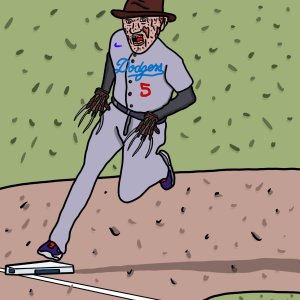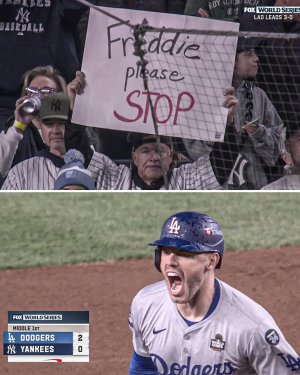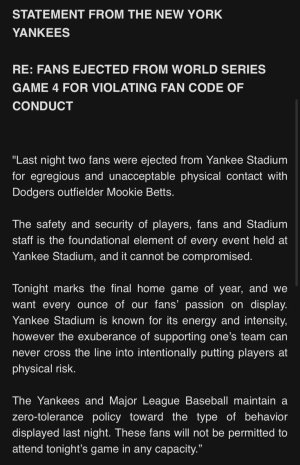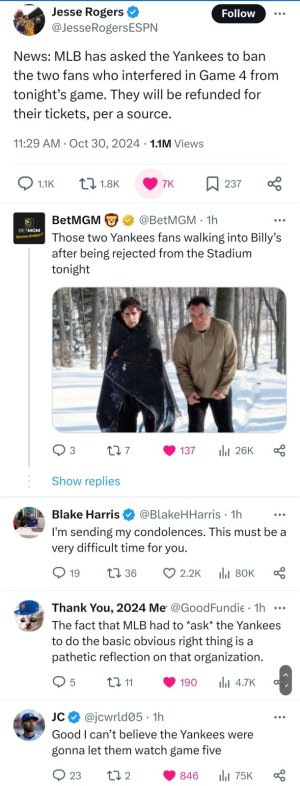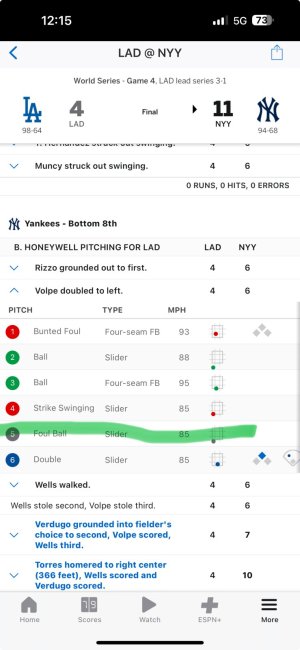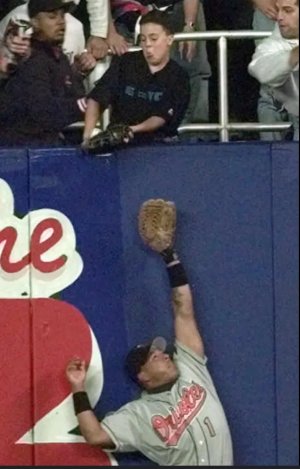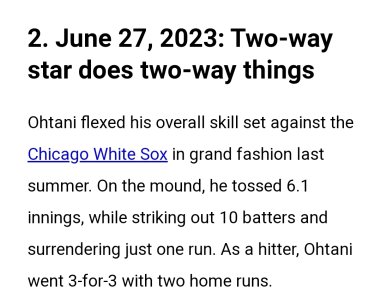- 12,097
- 13,204

Age: 21 (12/20/97)
Bats: R | Throws: R
6-foot-1 | 225 pounds
Top level: MLB | 2018 rank: 68
Wilson was Atlanta's fourth-round pick in its huge 2016 draft, which also netted Ian Anderson, Joey Wentz and Kyle Muller, and Wilson raced past all of them to make his major league debut in 2018. Wilson has the best overall fastball in Atlanta's system, with the pitch sitting at 95 to 96 mph and playing up with spin and life, and he has enough of a changeup to keep hitters honest, although he could use more repetitions with it to sell the pitch better. His slider is the weak spot; if that pitch were better, he would be a top-20 prospect, but right now it's a fringy pitch and he needs to throw it more, in the minors, before he's ready to step into a major league rotation.
He's still young, having just turned 21 in December, and already has come a long way since he was an athletic kid with a bad delivery and some arm strength just three springs ago. His aptitude for making adjustments and competitive nature bode well for him getting the secondary stuff to the point where he's at least a No. 3 starter.
 52. Spencer Howard, RHP, Philadelphia Phillies
52. Spencer Howard, RHP, Philadelphia Phillies
Age: 22 (7/28/96)
Bats: R | Throws: R
6-foot-3 | 205 pounds
Top level: A-ball | 2018 rank: Unranked
Howard was the Phillies' second-round pick in 2017, the 45th overall selection, but he has blown past almost everyone in their system to become their No. 2 prospect, even passing their 2017 first-rounder, Adam Haseley. Howard started the year with an average to above-average fastball but by midyear was sitting at 95 to 96 mph and topped out at over 98 mph at the end of the year. And his fastball really plays, because hitters don't see it well. He has a full arsenal with a plus slider that he calls a cutter as well as a solid-average changeup that he sells well out of his hand.
Just Missed | Top 100:100-51 | 50-1 | Impact 20 (Fri. Feb. 1)
• Team rankings: Top farm systems (Mon. Feb. 4) | Division-by-division (Tues. Feb 5-Sun. Feb. 10)
He was effective all year but improved as the season went on, with a 35 percent strikeout rate across his last 11 starts, roughly half his season. Howard spent all of last year in Low-A, which is a peculiar decision given how advanced he looked, how well he pitched and his experience as a college pitcher. So, the Phillies might consider bumping him to Double-A quickly, since he's already 22 and it's not as if we're waiting on him to throw harder. I hear a lot of No. 2 starter upside on him, with a high floor, and if he's throwing that hard that often, he should be able to get to the high minors soon.
 53. Daniel Lynch, LHP, Kansas City Royals
53. Daniel Lynch, LHP, Kansas City Royals
Age: 22 (11/17/96)
Bats: L | Throws: L
6-foot-6 | 190 pounds
Top level: A-ball | 2018 rank: Ineligible
Lynch came into last spring at the University of Virginia as a potential third- to fifth-round pick, a lefty with some feel to pitch but mostly average stuff and a question or two about his durability due to an old back injury. He finished the spring bumping 97 mph among a major-league-ready four-pitch mix, ending up at No. 26 on my draft board and going at pick No. 34 overall to the Royals, who have to be beyond thrilled with the results so far. Lynch pitched a full summer after signing, very unusual in this era of extreme caution around pitcher workloads, but he kept throwing better as the season progressed, dominating the full-season Sally League in nine starts -- 40 innings, 47 Ks, six walks and a 1.58 ERA.
Lynch really took off in pro ball once he was able to call his own game more, with his fastball sitting at 94 to 95 mph in many starts to go with an above-average slider and changeup and good deception from his delivery. He's still a little projectable, although his 6-foot-5 frame is wiry and he probably is not going to end up with a 240-pound workhorse body. But even if he's just a 180-inning guy, he has the command and stuff to be in a big league rotation very soon. Pro scouts who saw him in the Appy or Sally leagues all had the same question: How did this guy not go higher in the draft than the supplemental round? I think the whole industry will be asking that by the end of 2019.
 54. Luis Robert, CF, Chicago White Sox
54. Luis Robert, CF, Chicago White Sox
Age: 21 (8/3/97)
Bats: R | Throws: R
6-foot-3 | 185 pounds
Top level: High-A | 2018 rank: 46
Robert signed one of the last unfettered deals before the latest CBA put restrictions on international free agents under the age of 25, netting $26 million from the White Sox in May 2017 and making his stateside debut this past season. His campaign didn't go as planned, however, as Robert suffered a thumb injury in spring training that kept coming back, limiting him to just 50 games during the regular season and knocking him out for another week in the Arizona Fall League.
He is an impressive athlete with several plus tools, including 70-grade speed and plus raw power, and he reminded me physically of a young Jermaine Dye when I saw him take BP. (It has been a running joke with my Twitter followers that I haven't seen Robert play a game; I've gone somewhere to see his team four times, only to have him get hurt every time and miss the entire length of my trip.)
He is still raw at the plate and likes to expand the zone, with some mechanical issues in his swing that look like they'll contribute to more swings-and-misses than you'd like. He has star-level tools if he gets to them, which will require staying healthy and getting a full year of at-bats, but the potential for plus defense in center and even just mistake power should give him a high probability to be a solid everyday player.
 55. Khalil Lee, CF, Kansas City Royals
55. Khalil Lee, CF, Kansas City Royals
Age: 21 (6/26/9
Bats: L | Throws: L
5-foot-10 | 170 pounds
Top level: Double-A | 2018 rank: Unranked
Lee was the Royals' third-round pick in 2016 out of a prep school in northern Virginia. He had a strange full-season debut in 2017; he punched out 171 times (the ninth-highest total in the minors that year) but drew 65 walks and showed some power and above-average defense in center, with speed he didn't know how to utilize (20 steals in 38 attempts). In 2018, however, he showed tremendous growth on all sides of the ball, including a better two-strike approach that saw him cut his strikeout rate from nearly a third to just under a quarter of his plate appearances, although the change cost him some of his game power.
Lee has strong hands for hard contact, but his swing can still get big, and he rolls his front leg sometimes through contact, resulting in too many rollovers to the second baseman. He improved on the bases last year, especially in center field, where he always had a plus arm and enough speed to stay there but showed better reads and routes in 2018. There's some fourth-outfielder potential here, depending on how his body develops and whether his game power returns, but he also could be an above-average regular or more who goes 15/15 in steals and homers, with an OBP in the high .300s and value on defense in center.
 56. Luis Urias, 2B/SS, San Diego Padres
56. Luis Urias, 2B/SS, San Diego Padres
Age: 22 (6/3/97)
Bats: R | Throws: R
5-foot-9 | 185 pounds
Top level: MLB | 2018 rank: 38
Urias is listed at 5-foot-9 -- I'd take the under on that height -- but he has an impressive track record of hitting for average and high contact rates at every level of the minors. Urias' swing is compact, of course, but not so short that he can't drive the ball to the gaps. And his strike zone awareness has always been exceptional; he had more walks than strikeouts as a pro before he reached Triple-A in 2018. Urias reached the majors in September for a cup of coffee that ended early when he pulled a hamstring, an injury that has lingered into the offseason and prevented him from playing winter ball.
The brief sample did expose some weaknesses in his approach, as right-handed pitchers had success by attacking him with fastballs up and breaking stuff down and/or away, getting him to expand the zone more than he did in the minors. Urias has played plenty of shortstop in pro ball, but he's not a good enough defender there to play it every day. If his bat plays as expected, with high averages and OBPs, he'll be a regular at second base with above-average or even plus defense. There's a high utility infielder floor here too, given his positional versatility and ability to make contact; but the Padres are certainly hoping for more, given Urias' history of performance throughout the minors.
 57. Mike Soroka, RHP, Atlanta Braves
57. Mike Soroka, RHP, Atlanta Braves
Age: 21 (8/4/97)
Bats: R | Throws: R
6-foot-5 | 225 pounds
Top level: MLB | 2018 rank: 60
Soroka's major league debut was tantalizing, as his stuff, already good, was moving like crazy with a little help from the goofy major league ball, but five starts into his rookie season, his shoulder barked and he was shut down until instructional league. He is supposed to be 100 percent now and ready for spring training, which would be very good news for the Braves as they try to repeat as division champions. Soroka was throwing up to 95 mph with huge life on his two-seamer, also showing a plus changeup and sweepy slider that played up against right-handers because of his low arm slot.
He has filled out very well since Atlanta drafted him as a physically immature 17-year-old in 2015, and he hadn't had any arm issues until last year, even though he has that low slot and an arm swing that puts some stress on the shoulder. If he's healthy, he has mid-rotation potential, held back a little by the lack of a better breaking ball for right-handers but boosted by the potential to get a lot of ground balls with that crazy two-seam life.
 58. Justin Dunn, RHP, Seattle Mariners
58. Justin Dunn, RHP, Seattle Mariners
Age: 23 (9/22/95)
Bats: R | Throws: R
6-foot-2 | 185 pounds
Top level: Double-A | 2018 rank: Unranked
The "other" prospect who went to the Mariners in the Robinson Cano/Edwin Diaz deal is a solid player in his own right, a former first-rounder who got too caught up in spin rate in 2017 but bounced back with a huge 2018. Dunn was a reliever at Boston College until early in his junior year, when his velocity spiked and the Eagles' staff put him in the rotation. He is extremely athletic, but he was still somewhat raw for a college pitcher when the Mets drafted him; it took until 2018 to get him to a delivery he could repeat well, one that also gave him more extension out toward the plate to improve the carry on his mid-90s fastball and the finish on his slider.
The fastball alone plays right now, and both his slider and curveball can show plus, with the changeup the one pitch that's behind, in large part because he seldom had to use it as an amateur. I know of one opposing Double-A manager who said Dunn was the best pitcher his team had faced in all of 2018. He has more volatility in his projections, because he hasn't pitched a ton and still has work to do with his repertoire and command; but he has at least No. 2 starter upside, and you could squint hard and see even more if you truly believe in his athleticism and aptitude.
 59. Vidal Brujan, 2B, Tampa Bay Rays
59. Vidal Brujan, 2B, Tampa Bay Rays
Age: 21 (2/9/9
Bats: S | Throws: R
5-foot-9 | 155 pounds
Top level: High-A | 2018 rank: Unranked
Brujan has received relatively little hype to date, in part because he's in the Rays' system, and in part because he wasn't a high draft pick or big bonus guy on the international front. But he has hit at every level, with a career line of .300/.387/.426 through age 20, including a stint in High-A, and more walks in his career than strikeouts. It's not just performance, either, as Brujan is a plus runner with average power and a solid defender at second who could end up an asset there or maybe even be a plus defender in center.
He has a compact swing that so far has put the ball on the ground too often, just over 52 percent last year; although he seems like a good candidate for the kind of swing optimization that has acquired a cultlike following around the game, given his hand and upper body strength and feel for the zone.
 60. Mark Vientos, 3B, New York Mets
60. Mark Vientos, 3B, New York Mets
Age: 19 (12/11/99)
Bats: R | Throws: R
6-foot-4 | 185 pounds
Top level: Rookie | 2018 rank: Unranked
Vientos has been a bit of a forgotten man in the Mets' system, with more highly touted prospects around him, some playing at higher levels, as well as undue attention given to a publicity stunt in their Double-A outfield last year. But trades and Vientos' own progress have him as the system's best prospect now, and he is set to spend all of 2019 in full-season ball at age 19 after a very strong summer with short-season Kingsport as a true 18-year-old. Vientos finished tied for fourth in the Appalachian League in homers, fifth in walks and tied for 11th in doubles, with a swing optimized for launch angle but that also gets the barrel into the zone for enough time to maximize his hard contact.
A poor defensive shortstop in high school, Vientos has become an adequate defender at third, still improving but also still growing into his 6-foot-4 frame, so there's some chance he has to move off the position just due to sheer size. His OBP/contact/power profile should play anywhere, with his best chance to be a star coming at third but a high probability that he will be a regular even in right field or at first base.
 61. Deivi Garcia, RHP, New York Yankees
61. Deivi Garcia, RHP, New York Yankees
Age: 20 (5/19/99)
Bats: R | Throws: R
5-foot-10 | 163 pounds
Top level: Double-A | 2018 rank: Unranked
Marcus Stroman-sized and a bit slighter of build, so he has been dogged by questions about his durability, even as he dominated both levels of A-ball. Garcia has an easy low-90s fastball that sits 92 to 94 mph and sneaks up on hitters, while his bread and butter is his hammer curveball that's at least a 60-grade pitch now and could be more.
Scouts love his competitiveness, and even though he is small, he is aggressive and attacks hitters in the zone. When the Yankees promoted him to High-A in August, he no-hit Clearwater over seven innings in his first outing, striking out six of the first seven batters he faced. His changeup is his third pitch but should be at least average.
Garcia's delivery is simple, a little heavy on the arm with a moderately short stride, but he repeats it and has no problem throwing all his pitches for strikes. No one wants to assume a 5-foot-9 right-hander is a starter, but Garcia at least looks like he is built from the same mold as guys such as Stroman and Roy Oswalt; and through age 20, Garcia has had no trouble getting batters out.
 62. Leody Taveras, CF, Texas Rangers
62. Leody Taveras, CF, Texas Rangers
Age: 20 (9/8/9
Bats: S | Throws: R
6-foot-1 | 190 pounds
Top level: High-A | 2018 rank: 45
Taveras has been a slow developer as compared to the other kids from his July 2 class, two of whom now sit atop these rankings. But that's not a fair comparison, and Taveras has progressed very quickly for a teenager who has been promoted aggressively to High-A. He always has had a good approach for a teenager, with strong bat-to-ball skills. His strikeout rate was well above (better than) league average, even though he was the second-youngest regular in the Carolina League. His swing doesn't have much loft to it, and he's going to be a fringy power guy unless he alters his swing path at some point.
Taveras is a 70-grade defender in center with plus speed and an above-average arm, with his defense playing up thanks to strong instincts. Of course, at some point Taveras has to put together the season everyone has been anticipating, converting the approach and tools into more production, although I'm optimistic that 2019 will be a breakout year for him. The defense and contact rate would make him a regular for many clubs; if and when he converts his eye and feel for the barrel into .350+ OBPs, he'll be an above-average everyday player or more.
 63. DL Hall, LHP, Baltimore Orioles
63. DL Hall, LHP, Baltimore Orioles
Age: 20 (9/19/9
Bats: L | Throws: L
6-foot-2 | 195 pounds
Top level: A-ball | 2018 rank: Unranked
Hall was Baltimore's first-round pick in 2017, a potential top-10 talent who slipped a bit due to the bias against high school pitchers, his remote hometown and some makeup concerns. But his first full season in pro ball seems to have put most of those to the side, with scouts universally praising what they saw from him just a year out of Georgia high school ball. Hall would regularly pitch at 91 to 93 mph, touching 96, eventually running it up as high as 98 by the end of the summer, along with an above-average changeup and a curveball with big angle to it that varied from fringe-average to plus depending on when you saw him.
He is a good athlete who should develop more consistency to his delivery with repetition, while he already has the arm strength and feel both to spin the curveball and turn over the changeup that is all very hard to teach. There's some relief risk here just due to his inexperience and the need for him to develop a starter's command and pitching plan, but he has good mid-rotation upside and real value as a left-hander in an industry that still covets them.
 64. Eli Montero, 3B, St. Louis Cardinals
64. Eli Montero, 3B, St. Louis Cardinals
Age: 20 (8/17/9
Bats: R | Throws: R
6-foot-3 | 195 pounds
Top level: High-A | 2018 rank: Unranked
Montero came a bit out of nowhere to win the Midwest League MVP at age 19 last year, thanks to a .321/.381/.529 line that earned him a late-season promotion to High-A. He is a big, very strong kid who makes a lot of hard contact, with some pull power but also a lot of doubles the other way, strong enough to take pitches on the outer third and pull some of them into the seats. He has a solid idea of the zone and feel to hit, although he has just average bat speed and succeeds more on pure strength, even when he overswings, often wrapping his bat and getting very long to try to launch something. He plays third base now, but the consensus from scouts is that he'll end up at first.
There's a good starter kit here for a No. 4 or 5 hitter, a 25- to 30-homer guy with a solid OBP but maybe not as much average as you would want from a No. 2 or 3 hitter, enough for a regular or more even at first.
 65. Matt Manning, RHP, Detroit Tigers
65. Matt Manning, RHP, Detroit Tigers
Age: 21 (1/28/9
Bats: R | Throws: R
6-foot-6 | 190 pounds
Top level: Double-A | 2018 rank: Unranked
Manning looked like a bust in his first spring training after the Tigers took him with the ninth overall pick in 2016, as he lost the strike zone and had to be held back in extended spring training to rework his delivery. That effort paid off in 2018, as Manning looks like a new pitcher, with a better, less mechanical delivery that he can repeat well and that makes great use of his 6-foot-6 frame for huge extension out front, and better pure stuff than he had shown in the previous two summers.
Manning was a two-sport star in high school who had a basketball scholarship to Loyola Marymount and would hit 98 mph on his fastball but without great life and no feel for a breaking ball. In 2018, he would sit 92 to 95 and get more swings-and-misses on the fastball thanks to that extension, with a tighter 11/5 curveball up to 80 mph that showed above average and a changeup that is above average when he doesn't overthrow it.
Manning finished in the top 20 in the minors in total strikeouts and ended the year in Double-A, which puts him on track to see the majors in 2020, if not this year. There's still work to do, but the progress he has made in a fairly short time is a testament to his work ethic and athleticism, and there's good reason to believe he'll keep improving and get to a No. 3 starter upside.
 66. JoJo Romero, LHP, Philadelphia Phillies
66. JoJo Romero, LHP, Philadelphia Phillies
Age: 22 (9/9/96)
Bats: L | Throws: L
6-foot | 190 pounds
Top level: Double-A | 2018 rank:59
The Phillies were aggressive with Romero in 2018, pushing him to Double-A Reading, a very good hitter's park, after just 10 starts in High-A to end 2017, and he struggled for the first month with command and learning how to put away better hitters. Romero will show three above-average or better pitches, working 89 to 94 mph much of the time but able to reach back for 96 to 97 even deep into starts, while also showing a plus slider, above-average changeup and a curveball that's adequate but perhaps not needed in his arsenal. He has been a ground ball pitcher at every stop in the minors so far. He is an excellent fielder and controls the running game exceptionally well for a prospect, allowing just three stolen bases all season.
Romero's command still lags a little, and he has a tendency to spin off his front heel when he lands, which can pull him off line, even though his delivery gets him right toward the plate. His season ended in late July with a strained oblique muscle, costing him probably six or seven starts, and he'll likely need the full year in Triple-A before he is ready to come up, but there's at least No. 3 starter upside here with the chance for him to be truly plus if the command keeps improving.
 67. J.B. Bukauskas, RHP, Houston Astros
67. J.B. Bukauskas, RHP, Houston Astros
Age: 22 (10/11/96)
Bats: R | Throws: R
6-foot | 196 pounds
Top level: Double-A | 2018 rank: 74
The Astros' first-round pick in 2017 threw just 10 innings that season after signing, since he had been worked hard for three years at North Carolina, but his 2018 season was curtailed by a March car accident that led to a slipped disc and cost him two months of the regular season. When he returned, however, he was as good as ever. Bukauskas reached 99.7 mph in the Arizona Fall League, the hardest anyone had seen from him, so he appears to be fully recovered. He is a 6-foot right-hander with plus velocity and a plus slider and average changeup, showing some platoon split last year but not an alarming one, and he started working in a 90 to 91 mph cutter in the Fall League too.
Bukauskas has an aggressive, hypercompetitive style of pitching that would work well in just about any role. His delivery is not pretty, with most of the effort coming from his arm rather than his lower half, and his fastball can be flat due to his size and lack of plane. For all that, he has never had an arm injury, and he continued to miss bats and limit hard contact when he was able to pitch last year. I don't foresee him throwing 180 innings regularly, but he could be a mid-rotation starter if he holds up, and he has high upside in relief if the delivery eventually forces him out of a starter role.
 68. Daz Cameron, CF, Detroit Tigers
68. Daz Cameron, CF, Detroit Tigers
Age: 22 (1/15/97)
Bats: R | Throws: R
6-foot-2 | 195 pounds
Top level: Triple-A | 2018 rank: 86
Cameron continues to make quiet, steady progress, a strange contrast to when he was a bit overhyped as a high school prospect who suffered in comparison to his father, Mike. Cameron is an instinctive center fielder who should end up plus on defense and has enough speed to be an asset on the bases if he works on getting better reads off pitchers. Cameron isn't going to hit for the same sort of home run power his dad did, but he has plenty of gap power and goes the other way very effectively.
He is willing to run deep counts, so there should be on-base skills along with some high strikeout totals, which held true until his late-August promotion to Triple-A but resumed with a strong showing in the Arizona Fall League. His hands are loose, and he has good barrel control, just lacking much loft in his swing; but there's no mechanical reason to think he'll struggle with contact in the majors. He might only hit 12 to 15 homers, but with plus defense, a strong OBP and 20-odd steals to go with it, which would make him an above-average regular in center.
 69. Luis Garcia, SS, Philadelphia Phillies
69. Luis Garcia, SS, Philadelphia Phillies
Age: 18 (10/1/00)
Bats: S | Throws: R
5-foot-11 | 170 pounds
Top level: Rookie | 2018 rank: Unranked
The Phillies gave Garcia $2.5 million in 2017, and he has joined their pipeline of high-end international talent signed by their longtime international director, Sal Agostinelli, ripping through the Gulf Coast League last year at age 17 with a .369/.433/.488 line. He is a switch-hitting shortstop who projects to hit from both sides of the plate and stay at the position with above-average defense, with a better swing now from the right side and more tendency to chase hitting left-handed.
In the field, he already has made substantial progress from just a year in a pro system, particularly on being more consistent on routine plays, and even though he is going to end up an average runner, he projects to stay at short with above-average to plus defense. His makeup earns rave reviews from the Phillies' staff, from his maturity to his aptitude for learning -- and between that and the potential for a plus or better hit tool with high on-base skills, he could be a top-20 prospect in a year.
Josh James, RHP, Houston Astros
Age: 26 (3/8/93)
Bats: R | Throws: R
6-foot-3 | 206 pounds
Top level: MLB | 2018 rank: Unranked
A year ago, James was barely on the prospect radar. He threw hard but was out of shape, didn't throw enough strikes or miss enough bats to be a potential starter and ended 2017 on the worst possible note -- giving up 19 runs in his last four starts in Double-A over just 8⅔ innings, while ending up in the team's doghouse for non-baseball reasons, as well. He recommitted to his career in the offseason, getting his body in much better shape, and showed up in 2018 a new pitcher, throwing harder than ever with more life and a harder slider, ending the year in the majors -- where he bumped 101 mph in his debut.
James has gone from a maybe-reliever to a likely starter, with a huge fastball that plays, a plus slider and an average changeup, and he holds his stuff deep into starts. You can dream on him pitching atop a rotation, although his command probably will keep him more in the above-average category -- but to get there from where he was 15 months ago is a heck of an achievement.
 71. Jesus Sanchez, OF, Tampa Bay Rays
71. Jesus Sanchez, OF, Tampa Bay Rays
Age: 21 (10/7/97)
Bats: L | Throws: R
6-foot-3 | 210 pounds
Top level: Double-A | 2018 rank: 34
Sanchez continued to swing at everything and hit a lot of it, generally hitting it hard, as a 20-year-old in High-A last year (with a late-summer bump to Double-A), and the Oscar Taveras comparisons that have stuck to him since his pro debut still seem to hold. Sanchez has always had a preternatural ability to hit, from when he first signed, and he posts some of the best exit velocities in the Rays' system, although his approach -- see ball, hit ball -- remains unrefined. Because he can make contact with so many pitches out of the zone, he tends to expand too easily, so he doesn't walk much and rolls over to the right side too often.
He is going to end up in right field, with a plus arm and probably average range. With his potential to hit .300 regularly with 18 to 22 homers, even with low walk rates he should be at least an everyday regular with the potential to grow into more.
 72. Cole Winn, RHP, Texas Rangers
72. Cole Winn, RHP, Texas Rangers
Age: 19 (11/25/99)
Bats: R | Throws: R
6-foot-2 | 190 pounds
Top level: Has yet to play | 2018 rank: Ineligible
Winn was the top command guy in last year's high school class, offering less projection than your typical prep arm but more polish and a more advanced feel for the craft of pitching. Winn pitched in Colorado until his senior year, when he moved to California and enrolled at Orange Lutheran; and before his senior year, he tightened up his delivery while watching his stuff creep up to above average, with fastball velocity topping out at 95 mph and also showing average command of both a curve and a slider. He has a big stride toward the plate to finish over his front side, gaining extension and extracting the most velocity he can from his lower half.
His changeup still lags his other weapons, and if he's going to work with a grade-55 fastball, his command will have to stay where we all saw it last spring for him to remain a starter; but his delivery and makeup say he can do it, with the upside of an above-average major league starter.
 73. Brandon Marsh, OF, Los Angeles Angels
73. Brandon Marsh, OF, Los Angeles Angels
Age: 21 (12/18/97)
Bats: L | Throws: R
6-foot-4 | 210 pounds
Top level: High-A | 2018 rank: 88
Marsh started 2018 in the Midwest League, making his full-season debut at age 20. He was so good so early, hitting .295/.390/.470, that the Angels bumped him right up after 34 games to High-A, where he continued to rack up walks and display doubles power. Marsh is an exceptional athlete who shows great instincts on both sides of the ball as well as on the basepaths, with 55/60-grade speed that plays up as a result.
He is a plus defender in center both in range and arm, and his bat has so far played out for good on-base/doubles skills, with untapped power that might require a small tweak to his swing finish to unleash. His defensive chops and athleticism give him a high floor as an extra outfielder, but it's easy to see him becoming a four-win player with on-base skills and even 15 or so homers a year.
 74. Bo (Noah) Naylor, C/3B, Cleveland Indians
74. Bo (Noah) Naylor, C/3B, Cleveland Indians
Age: 19 (2/21/00)
Bats: L | Throws: R
6-foot | 195 pounds
Top level: Rookie | 2018 rank: Ineligible
Naylor was 14th on my draft board but was still available for Cleveland at pick 29, where it had to be ecstatic to land one of the draft's best position player prospects -- even though it's still not clear what position he'll play. Naylor caught and played in the infield as an amateur, and Cleveland plans to develop him as a catcher while also giving him reps at third base, with second base always a possibility down the line, to maintain some flexibility. He is a superb athlete who gets raves for his on-field intelligence, and he has real tools in a plus arm, plus speed and real feel to hit, rolling right out of the draft to post a .381 OBP in the Arizona Rookie League that would have ranked in the top 20 had he qualified.
He is a work in progress as a receiver, with plenty of arm strength and the agility for the position but lacking the receiving and game-calling skills he'll need to catch. I have little doubt he would be at least a 55-grade defender at third or second and that his bat will play at any of those spots; but of course, he has the highest upside if he remains behind the dish. Regardless of his position, Cleveland seems to have landed a good regular, maybe a lot more, at a spot in the draft when someone with his upside should have been long gone.
He's still young, having just turned 21 in December, and already has come a long way since he was an athletic kid with a bad delivery and some arm strength just three springs ago. His aptitude for making adjustments and competitive nature bode well for him getting the secondary stuff to the point where he's at least a No. 3 starter.

Age: 22 (7/28/96)
Bats: R | Throws: R
6-foot-3 | 205 pounds
Top level: A-ball | 2018 rank: Unranked
Howard was the Phillies' second-round pick in 2017, the 45th overall selection, but he has blown past almost everyone in their system to become their No. 2 prospect, even passing their 2017 first-rounder, Adam Haseley. Howard started the year with an average to above-average fastball but by midyear was sitting at 95 to 96 mph and topped out at over 98 mph at the end of the year. And his fastball really plays, because hitters don't see it well. He has a full arsenal with a plus slider that he calls a cutter as well as a solid-average changeup that he sells well out of his hand.
Just Missed | Top 100:100-51 | 50-1 | Impact 20 (Fri. Feb. 1)
• Team rankings: Top farm systems (Mon. Feb. 4) | Division-by-division (Tues. Feb 5-Sun. Feb. 10)
He was effective all year but improved as the season went on, with a 35 percent strikeout rate across his last 11 starts, roughly half his season. Howard spent all of last year in Low-A, which is a peculiar decision given how advanced he looked, how well he pitched and his experience as a college pitcher. So, the Phillies might consider bumping him to Double-A quickly, since he's already 22 and it's not as if we're waiting on him to throw harder. I hear a lot of No. 2 starter upside on him, with a high floor, and if he's throwing that hard that often, he should be able to get to the high minors soon.

Age: 22 (11/17/96)
Bats: L | Throws: L
6-foot-6 | 190 pounds
Top level: A-ball | 2018 rank: Ineligible
Lynch came into last spring at the University of Virginia as a potential third- to fifth-round pick, a lefty with some feel to pitch but mostly average stuff and a question or two about his durability due to an old back injury. He finished the spring bumping 97 mph among a major-league-ready four-pitch mix, ending up at No. 26 on my draft board and going at pick No. 34 overall to the Royals, who have to be beyond thrilled with the results so far. Lynch pitched a full summer after signing, very unusual in this era of extreme caution around pitcher workloads, but he kept throwing better as the season progressed, dominating the full-season Sally League in nine starts -- 40 innings, 47 Ks, six walks and a 1.58 ERA.
Lynch really took off in pro ball once he was able to call his own game more, with his fastball sitting at 94 to 95 mph in many starts to go with an above-average slider and changeup and good deception from his delivery. He's still a little projectable, although his 6-foot-5 frame is wiry and he probably is not going to end up with a 240-pound workhorse body. But even if he's just a 180-inning guy, he has the command and stuff to be in a big league rotation very soon. Pro scouts who saw him in the Appy or Sally leagues all had the same question: How did this guy not go higher in the draft than the supplemental round? I think the whole industry will be asking that by the end of 2019.

Age: 21 (8/3/97)
Bats: R | Throws: R
6-foot-3 | 185 pounds
Top level: High-A | 2018 rank: 46
Robert signed one of the last unfettered deals before the latest CBA put restrictions on international free agents under the age of 25, netting $26 million from the White Sox in May 2017 and making his stateside debut this past season. His campaign didn't go as planned, however, as Robert suffered a thumb injury in spring training that kept coming back, limiting him to just 50 games during the regular season and knocking him out for another week in the Arizona Fall League.
He is an impressive athlete with several plus tools, including 70-grade speed and plus raw power, and he reminded me physically of a young Jermaine Dye when I saw him take BP. (It has been a running joke with my Twitter followers that I haven't seen Robert play a game; I've gone somewhere to see his team four times, only to have him get hurt every time and miss the entire length of my trip.)
He is still raw at the plate and likes to expand the zone, with some mechanical issues in his swing that look like they'll contribute to more swings-and-misses than you'd like. He has star-level tools if he gets to them, which will require staying healthy and getting a full year of at-bats, but the potential for plus defense in center and even just mistake power should give him a high probability to be a solid everyday player.

Age: 21 (6/26/9

Bats: L | Throws: L
5-foot-10 | 170 pounds
Top level: Double-A | 2018 rank: Unranked
Lee was the Royals' third-round pick in 2016 out of a prep school in northern Virginia. He had a strange full-season debut in 2017; he punched out 171 times (the ninth-highest total in the minors that year) but drew 65 walks and showed some power and above-average defense in center, with speed he didn't know how to utilize (20 steals in 38 attempts). In 2018, however, he showed tremendous growth on all sides of the ball, including a better two-strike approach that saw him cut his strikeout rate from nearly a third to just under a quarter of his plate appearances, although the change cost him some of his game power.
Lee has strong hands for hard contact, but his swing can still get big, and he rolls his front leg sometimes through contact, resulting in too many rollovers to the second baseman. He improved on the bases last year, especially in center field, where he always had a plus arm and enough speed to stay there but showed better reads and routes in 2018. There's some fourth-outfielder potential here, depending on how his body develops and whether his game power returns, but he also could be an above-average regular or more who goes 15/15 in steals and homers, with an OBP in the high .300s and value on defense in center.

Age: 22 (6/3/97)
Bats: R | Throws: R
5-foot-9 | 185 pounds
Top level: MLB | 2018 rank: 38
Urias is listed at 5-foot-9 -- I'd take the under on that height -- but he has an impressive track record of hitting for average and high contact rates at every level of the minors. Urias' swing is compact, of course, but not so short that he can't drive the ball to the gaps. And his strike zone awareness has always been exceptional; he had more walks than strikeouts as a pro before he reached Triple-A in 2018. Urias reached the majors in September for a cup of coffee that ended early when he pulled a hamstring, an injury that has lingered into the offseason and prevented him from playing winter ball.
The brief sample did expose some weaknesses in his approach, as right-handed pitchers had success by attacking him with fastballs up and breaking stuff down and/or away, getting him to expand the zone more than he did in the minors. Urias has played plenty of shortstop in pro ball, but he's not a good enough defender there to play it every day. If his bat plays as expected, with high averages and OBPs, he'll be a regular at second base with above-average or even plus defense. There's a high utility infielder floor here too, given his positional versatility and ability to make contact; but the Padres are certainly hoping for more, given Urias' history of performance throughout the minors.

Age: 21 (8/4/97)
Bats: R | Throws: R
6-foot-5 | 225 pounds
Top level: MLB | 2018 rank: 60
Soroka's major league debut was tantalizing, as his stuff, already good, was moving like crazy with a little help from the goofy major league ball, but five starts into his rookie season, his shoulder barked and he was shut down until instructional league. He is supposed to be 100 percent now and ready for spring training, which would be very good news for the Braves as they try to repeat as division champions. Soroka was throwing up to 95 mph with huge life on his two-seamer, also showing a plus changeup and sweepy slider that played up against right-handers because of his low arm slot.
He has filled out very well since Atlanta drafted him as a physically immature 17-year-old in 2015, and he hadn't had any arm issues until last year, even though he has that low slot and an arm swing that puts some stress on the shoulder. If he's healthy, he has mid-rotation potential, held back a little by the lack of a better breaking ball for right-handers but boosted by the potential to get a lot of ground balls with that crazy two-seam life.

Age: 23 (9/22/95)
Bats: R | Throws: R
6-foot-2 | 185 pounds
Top level: Double-A | 2018 rank: Unranked
The "other" prospect who went to the Mariners in the Robinson Cano/Edwin Diaz deal is a solid player in his own right, a former first-rounder who got too caught up in spin rate in 2017 but bounced back with a huge 2018. Dunn was a reliever at Boston College until early in his junior year, when his velocity spiked and the Eagles' staff put him in the rotation. He is extremely athletic, but he was still somewhat raw for a college pitcher when the Mets drafted him; it took until 2018 to get him to a delivery he could repeat well, one that also gave him more extension out toward the plate to improve the carry on his mid-90s fastball and the finish on his slider.
The fastball alone plays right now, and both his slider and curveball can show plus, with the changeup the one pitch that's behind, in large part because he seldom had to use it as an amateur. I know of one opposing Double-A manager who said Dunn was the best pitcher his team had faced in all of 2018. He has more volatility in his projections, because he hasn't pitched a ton and still has work to do with his repertoire and command; but he has at least No. 2 starter upside, and you could squint hard and see even more if you truly believe in his athleticism and aptitude.

Age: 21 (2/9/9

Bats: S | Throws: R
5-foot-9 | 155 pounds
Top level: High-A | 2018 rank: Unranked
Brujan has received relatively little hype to date, in part because he's in the Rays' system, and in part because he wasn't a high draft pick or big bonus guy on the international front. But he has hit at every level, with a career line of .300/.387/.426 through age 20, including a stint in High-A, and more walks in his career than strikeouts. It's not just performance, either, as Brujan is a plus runner with average power and a solid defender at second who could end up an asset there or maybe even be a plus defender in center.
He has a compact swing that so far has put the ball on the ground too often, just over 52 percent last year; although he seems like a good candidate for the kind of swing optimization that has acquired a cultlike following around the game, given his hand and upper body strength and feel for the zone.

Age: 19 (12/11/99)
Bats: R | Throws: R
6-foot-4 | 185 pounds
Top level: Rookie | 2018 rank: Unranked
Vientos has been a bit of a forgotten man in the Mets' system, with more highly touted prospects around him, some playing at higher levels, as well as undue attention given to a publicity stunt in their Double-A outfield last year. But trades and Vientos' own progress have him as the system's best prospect now, and he is set to spend all of 2019 in full-season ball at age 19 after a very strong summer with short-season Kingsport as a true 18-year-old. Vientos finished tied for fourth in the Appalachian League in homers, fifth in walks and tied for 11th in doubles, with a swing optimized for launch angle but that also gets the barrel into the zone for enough time to maximize his hard contact.
A poor defensive shortstop in high school, Vientos has become an adequate defender at third, still improving but also still growing into his 6-foot-4 frame, so there's some chance he has to move off the position just due to sheer size. His OBP/contact/power profile should play anywhere, with his best chance to be a star coming at third but a high probability that he will be a regular even in right field or at first base.

Age: 20 (5/19/99)
Bats: R | Throws: R
5-foot-10 | 163 pounds
Top level: Double-A | 2018 rank: Unranked
Marcus Stroman-sized and a bit slighter of build, so he has been dogged by questions about his durability, even as he dominated both levels of A-ball. Garcia has an easy low-90s fastball that sits 92 to 94 mph and sneaks up on hitters, while his bread and butter is his hammer curveball that's at least a 60-grade pitch now and could be more.
Scouts love his competitiveness, and even though he is small, he is aggressive and attacks hitters in the zone. When the Yankees promoted him to High-A in August, he no-hit Clearwater over seven innings in his first outing, striking out six of the first seven batters he faced. His changeup is his third pitch but should be at least average.
Garcia's delivery is simple, a little heavy on the arm with a moderately short stride, but he repeats it and has no problem throwing all his pitches for strikes. No one wants to assume a 5-foot-9 right-hander is a starter, but Garcia at least looks like he is built from the same mold as guys such as Stroman and Roy Oswalt; and through age 20, Garcia has had no trouble getting batters out.

Age: 20 (9/8/9

Bats: S | Throws: R
6-foot-1 | 190 pounds
Top level: High-A | 2018 rank: 45
Taveras has been a slow developer as compared to the other kids from his July 2 class, two of whom now sit atop these rankings. But that's not a fair comparison, and Taveras has progressed very quickly for a teenager who has been promoted aggressively to High-A. He always has had a good approach for a teenager, with strong bat-to-ball skills. His strikeout rate was well above (better than) league average, even though he was the second-youngest regular in the Carolina League. His swing doesn't have much loft to it, and he's going to be a fringy power guy unless he alters his swing path at some point.
Taveras is a 70-grade defender in center with plus speed and an above-average arm, with his defense playing up thanks to strong instincts. Of course, at some point Taveras has to put together the season everyone has been anticipating, converting the approach and tools into more production, although I'm optimistic that 2019 will be a breakout year for him. The defense and contact rate would make him a regular for many clubs; if and when he converts his eye and feel for the barrel into .350+ OBPs, he'll be an above-average everyday player or more.

Age: 20 (9/19/9

Bats: L | Throws: L
6-foot-2 | 195 pounds
Top level: A-ball | 2018 rank: Unranked
Hall was Baltimore's first-round pick in 2017, a potential top-10 talent who slipped a bit due to the bias against high school pitchers, his remote hometown and some makeup concerns. But his first full season in pro ball seems to have put most of those to the side, with scouts universally praising what they saw from him just a year out of Georgia high school ball. Hall would regularly pitch at 91 to 93 mph, touching 96, eventually running it up as high as 98 by the end of the summer, along with an above-average changeup and a curveball with big angle to it that varied from fringe-average to plus depending on when you saw him.
He is a good athlete who should develop more consistency to his delivery with repetition, while he already has the arm strength and feel both to spin the curveball and turn over the changeup that is all very hard to teach. There's some relief risk here just due to his inexperience and the need for him to develop a starter's command and pitching plan, but he has good mid-rotation upside and real value as a left-hander in an industry that still covets them.

Age: 20 (8/17/9

Bats: R | Throws: R
6-foot-3 | 195 pounds
Top level: High-A | 2018 rank: Unranked
Montero came a bit out of nowhere to win the Midwest League MVP at age 19 last year, thanks to a .321/.381/.529 line that earned him a late-season promotion to High-A. He is a big, very strong kid who makes a lot of hard contact, with some pull power but also a lot of doubles the other way, strong enough to take pitches on the outer third and pull some of them into the seats. He has a solid idea of the zone and feel to hit, although he has just average bat speed and succeeds more on pure strength, even when he overswings, often wrapping his bat and getting very long to try to launch something. He plays third base now, but the consensus from scouts is that he'll end up at first.
There's a good starter kit here for a No. 4 or 5 hitter, a 25- to 30-homer guy with a solid OBP but maybe not as much average as you would want from a No. 2 or 3 hitter, enough for a regular or more even at first.

Age: 21 (1/28/9

Bats: R | Throws: R
6-foot-6 | 190 pounds
Top level: Double-A | 2018 rank: Unranked
Manning looked like a bust in his first spring training after the Tigers took him with the ninth overall pick in 2016, as he lost the strike zone and had to be held back in extended spring training to rework his delivery. That effort paid off in 2018, as Manning looks like a new pitcher, with a better, less mechanical delivery that he can repeat well and that makes great use of his 6-foot-6 frame for huge extension out front, and better pure stuff than he had shown in the previous two summers.
Manning was a two-sport star in high school who had a basketball scholarship to Loyola Marymount and would hit 98 mph on his fastball but without great life and no feel for a breaking ball. In 2018, he would sit 92 to 95 and get more swings-and-misses on the fastball thanks to that extension, with a tighter 11/5 curveball up to 80 mph that showed above average and a changeup that is above average when he doesn't overthrow it.
Manning finished in the top 20 in the minors in total strikeouts and ended the year in Double-A, which puts him on track to see the majors in 2020, if not this year. There's still work to do, but the progress he has made in a fairly short time is a testament to his work ethic and athleticism, and there's good reason to believe he'll keep improving and get to a No. 3 starter upside.

Age: 22 (9/9/96)
Bats: L | Throws: L
6-foot | 190 pounds
Top level: Double-A | 2018 rank:59
The Phillies were aggressive with Romero in 2018, pushing him to Double-A Reading, a very good hitter's park, after just 10 starts in High-A to end 2017, and he struggled for the first month with command and learning how to put away better hitters. Romero will show three above-average or better pitches, working 89 to 94 mph much of the time but able to reach back for 96 to 97 even deep into starts, while also showing a plus slider, above-average changeup and a curveball that's adequate but perhaps not needed in his arsenal. He has been a ground ball pitcher at every stop in the minors so far. He is an excellent fielder and controls the running game exceptionally well for a prospect, allowing just three stolen bases all season.
Romero's command still lags a little, and he has a tendency to spin off his front heel when he lands, which can pull him off line, even though his delivery gets him right toward the plate. His season ended in late July with a strained oblique muscle, costing him probably six or seven starts, and he'll likely need the full year in Triple-A before he is ready to come up, but there's at least No. 3 starter upside here with the chance for him to be truly plus if the command keeps improving.

Age: 22 (10/11/96)
Bats: R | Throws: R
6-foot | 196 pounds
Top level: Double-A | 2018 rank: 74
The Astros' first-round pick in 2017 threw just 10 innings that season after signing, since he had been worked hard for three years at North Carolina, but his 2018 season was curtailed by a March car accident that led to a slipped disc and cost him two months of the regular season. When he returned, however, he was as good as ever. Bukauskas reached 99.7 mph in the Arizona Fall League, the hardest anyone had seen from him, so he appears to be fully recovered. He is a 6-foot right-hander with plus velocity and a plus slider and average changeup, showing some platoon split last year but not an alarming one, and he started working in a 90 to 91 mph cutter in the Fall League too.
Bukauskas has an aggressive, hypercompetitive style of pitching that would work well in just about any role. His delivery is not pretty, with most of the effort coming from his arm rather than his lower half, and his fastball can be flat due to his size and lack of plane. For all that, he has never had an arm injury, and he continued to miss bats and limit hard contact when he was able to pitch last year. I don't foresee him throwing 180 innings regularly, but he could be a mid-rotation starter if he holds up, and he has high upside in relief if the delivery eventually forces him out of a starter role.

Age: 22 (1/15/97)
Bats: R | Throws: R
6-foot-2 | 195 pounds
Top level: Triple-A | 2018 rank: 86
Cameron continues to make quiet, steady progress, a strange contrast to when he was a bit overhyped as a high school prospect who suffered in comparison to his father, Mike. Cameron is an instinctive center fielder who should end up plus on defense and has enough speed to be an asset on the bases if he works on getting better reads off pitchers. Cameron isn't going to hit for the same sort of home run power his dad did, but he has plenty of gap power and goes the other way very effectively.
He is willing to run deep counts, so there should be on-base skills along with some high strikeout totals, which held true until his late-August promotion to Triple-A but resumed with a strong showing in the Arizona Fall League. His hands are loose, and he has good barrel control, just lacking much loft in his swing; but there's no mechanical reason to think he'll struggle with contact in the majors. He might only hit 12 to 15 homers, but with plus defense, a strong OBP and 20-odd steals to go with it, which would make him an above-average regular in center.

Age: 18 (10/1/00)
Bats: S | Throws: R
5-foot-11 | 170 pounds
Top level: Rookie | 2018 rank: Unranked
The Phillies gave Garcia $2.5 million in 2017, and he has joined their pipeline of high-end international talent signed by their longtime international director, Sal Agostinelli, ripping through the Gulf Coast League last year at age 17 with a .369/.433/.488 line. He is a switch-hitting shortstop who projects to hit from both sides of the plate and stay at the position with above-average defense, with a better swing now from the right side and more tendency to chase hitting left-handed.
In the field, he already has made substantial progress from just a year in a pro system, particularly on being more consistent on routine plays, and even though he is going to end up an average runner, he projects to stay at short with above-average to plus defense. His makeup earns rave reviews from the Phillies' staff, from his maturity to his aptitude for learning -- and between that and the potential for a plus or better hit tool with high on-base skills, he could be a top-20 prospect in a year.
Josh James, RHP, Houston Astros
Age: 26 (3/8/93)
Bats: R | Throws: R
6-foot-3 | 206 pounds
Top level: MLB | 2018 rank: Unranked
A year ago, James was barely on the prospect radar. He threw hard but was out of shape, didn't throw enough strikes or miss enough bats to be a potential starter and ended 2017 on the worst possible note -- giving up 19 runs in his last four starts in Double-A over just 8⅔ innings, while ending up in the team's doghouse for non-baseball reasons, as well. He recommitted to his career in the offseason, getting his body in much better shape, and showed up in 2018 a new pitcher, throwing harder than ever with more life and a harder slider, ending the year in the majors -- where he bumped 101 mph in his debut.
James has gone from a maybe-reliever to a likely starter, with a huge fastball that plays, a plus slider and an average changeup, and he holds his stuff deep into starts. You can dream on him pitching atop a rotation, although his command probably will keep him more in the above-average category -- but to get there from where he was 15 months ago is a heck of an achievement.

Age: 21 (10/7/97)
Bats: L | Throws: R
6-foot-3 | 210 pounds
Top level: Double-A | 2018 rank: 34
Sanchez continued to swing at everything and hit a lot of it, generally hitting it hard, as a 20-year-old in High-A last year (with a late-summer bump to Double-A), and the Oscar Taveras comparisons that have stuck to him since his pro debut still seem to hold. Sanchez has always had a preternatural ability to hit, from when he first signed, and he posts some of the best exit velocities in the Rays' system, although his approach -- see ball, hit ball -- remains unrefined. Because he can make contact with so many pitches out of the zone, he tends to expand too easily, so he doesn't walk much and rolls over to the right side too often.
He is going to end up in right field, with a plus arm and probably average range. With his potential to hit .300 regularly with 18 to 22 homers, even with low walk rates he should be at least an everyday regular with the potential to grow into more.

Age: 19 (11/25/99)
Bats: R | Throws: R
6-foot-2 | 190 pounds
Top level: Has yet to play | 2018 rank: Ineligible
Winn was the top command guy in last year's high school class, offering less projection than your typical prep arm but more polish and a more advanced feel for the craft of pitching. Winn pitched in Colorado until his senior year, when he moved to California and enrolled at Orange Lutheran; and before his senior year, he tightened up his delivery while watching his stuff creep up to above average, with fastball velocity topping out at 95 mph and also showing average command of both a curve and a slider. He has a big stride toward the plate to finish over his front side, gaining extension and extracting the most velocity he can from his lower half.
His changeup still lags his other weapons, and if he's going to work with a grade-55 fastball, his command will have to stay where we all saw it last spring for him to remain a starter; but his delivery and makeup say he can do it, with the upside of an above-average major league starter.

Age: 21 (12/18/97)
Bats: L | Throws: R
6-foot-4 | 210 pounds
Top level: High-A | 2018 rank: 88
Marsh started 2018 in the Midwest League, making his full-season debut at age 20. He was so good so early, hitting .295/.390/.470, that the Angels bumped him right up after 34 games to High-A, where he continued to rack up walks and display doubles power. Marsh is an exceptional athlete who shows great instincts on both sides of the ball as well as on the basepaths, with 55/60-grade speed that plays up as a result.
He is a plus defender in center both in range and arm, and his bat has so far played out for good on-base/doubles skills, with untapped power that might require a small tweak to his swing finish to unleash. His defensive chops and athleticism give him a high floor as an extra outfielder, but it's easy to see him becoming a four-win player with on-base skills and even 15 or so homers a year.

Age: 19 (2/21/00)
Bats: L | Throws: R
6-foot | 195 pounds
Top level: Rookie | 2018 rank: Ineligible
Naylor was 14th on my draft board but was still available for Cleveland at pick 29, where it had to be ecstatic to land one of the draft's best position player prospects -- even though it's still not clear what position he'll play. Naylor caught and played in the infield as an amateur, and Cleveland plans to develop him as a catcher while also giving him reps at third base, with second base always a possibility down the line, to maintain some flexibility. He is a superb athlete who gets raves for his on-field intelligence, and he has real tools in a plus arm, plus speed and real feel to hit, rolling right out of the draft to post a .381 OBP in the Arizona Rookie League that would have ranked in the top 20 had he qualified.
He is a work in progress as a receiver, with plenty of arm strength and the agility for the position but lacking the receiving and game-calling skills he'll need to catch. I have little doubt he would be at least a 55-grade defender at third or second and that his bat will play at any of those spots; but of course, he has the highest upside if he remains behind the dish. Regardless of his position, Cleveland seems to have landed a good regular, maybe a lot more, at a spot in the draft when someone with his upside should have been long gone.
Last edited:




















